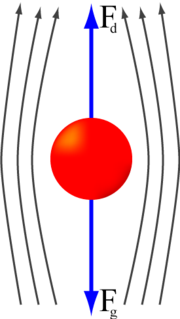Terminal velocity From Wikipedia, the free encyclopedia • Ten things you may not know about Wikipedia • Jump to: navigation, search For other uses, see Terminal velocity (disambiguation). 

An object reaches terminal velocity when the downward force of gravity (Fg)equals the upward force of drag (Fd). (Teahupoo, Waimea, Pipe would seem to be examples of the propagation upflow increasing drag on a rider trying to get down the face such that the drag reduces positive velocity toward the bottom, sometimes making the rider’s progress toward the bottom negative–this would have effects at other attitudes/vectors too–definitely advantageous when climbing and perhaps when maintaining a high line trim through a steep face/tunnel)
The net force on the body is then zero, and the result is that the (downward) velocity of the object remains constant. (Terminal velocity and trim given a set glide angle being the same. Pilots know this.)
As the object accelerates (usually downwards due to gravity), the drag force acting on the object increases. At a particular speed, the drag force produced will equal the object’s weight (mg). Eventually, it plummets at a constant speed called terminal velocity (also called settling velocity). Terminal velocity varies directly with the ratio of drag to weight. More drag means a lower terminal velocity, while increased weight means a higher terminal velocity. An object moving downward at greater than terminal velocity (for example because it was affected by a downward force or it fell from a thinner part of the atmosphere or it changed shape) will slow until it reaches terminal velocity.
For example, the terminal velocity of a skydiver in a free-fall position with a semi-closed parachute is about 195 km/h (120 mph or 55m/s)[1]. This velocity is the asymptotic limiting value of the acceleration process, since the effective forces on the body more and more closely balance each other as the terminal velocity is approached. In this example, a speed of 50% of terminal velocity is reached after only about 3 seconds, while it takes 8 seconds to reach 90%, 15 seconds to reach 99% and so on.
Higher speeds can be attained if the skydiver pulls in his limbs (see also freeflying). In this case, the terminal velocity increases to about 320 km/h (200 mph or 89 m/s)[1], which is also the terminal velocity of the peregrine falcon diving down on its prey[2], and a typical 150 g bullet travelling in the downward vertical direction which is returning to earth having been fired upwards or perhaps just dropped from a tower, which has a terminal velocity of about 300 feet per second (90 m/s) according to a 1920 U.S. Army Ordnance study[3].
Competition speed skydivers fly in the head down position reaching even higher speeds. The current world record is 614 mph (988 km/h) by Joseph Kittinger, set at high altitude where the lesser density of the atmosphere decreased drag[1].
An object falling on Earth will fall 9.80 meters per second faster every second (9.8 m/s²). The reason an object reaches a terminal velocity is that the drag force resisting motion is directly proportional to the square of its speed. At low speeds, the drag is much less than the gravitational force and so the object accelerates. As it accelerates, the drag increases, until it equals the weight. Drag also depends on the projected area. This is why things with a large projected area, such as parachutes, have a lower terminal velocity than small objects such as cannon balls.
Mathematically, terminal velocity, without considering the buoyancy effects, is given by  (see derivation)
(see derivation)
where Vt = terminal velocity,m = mass of the falling object,g = gravitational acceleration,Cd = drag coefficient,ρ = density of the fluid through which the object is falling, andA = projected area of the object.
Also relevant: http://www.grc.nasa.gov/WWW/K-12/airplane/right2.html:
Lift Generated in a Moving Fluid
For a body immersed in a moving fluid, the fluid remains in contact with the surface of the body. If the body is shaped, moved, or inclined in such a way as to produce a net deflection or turning of the flow, the local velocity is changed in magnitude, direction, or both. Changing the velocity creates a net force on the body. It is very important to note that the turning of the fluid occurs because the molecules of the fluid stay in contact with the solid body since the molecules are free to move. Any part of the solid body can deflect a flow. Parts facing the oncoming flow are said to be windward, and parts facing away from the flow are said to be leeward. Both windward and leeward parts deflect a flow. Ignoring the leeward deflection leads to a popular incorrect theory of lift.


 (
(